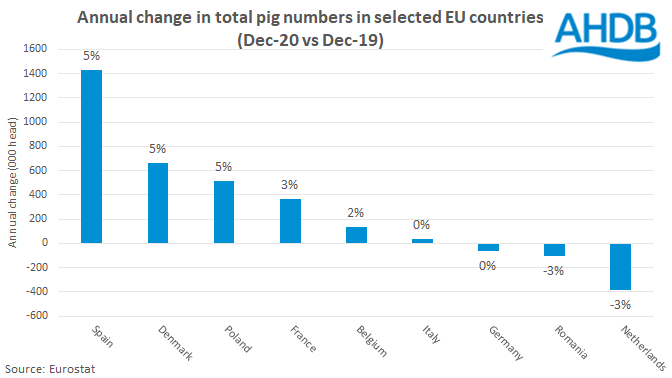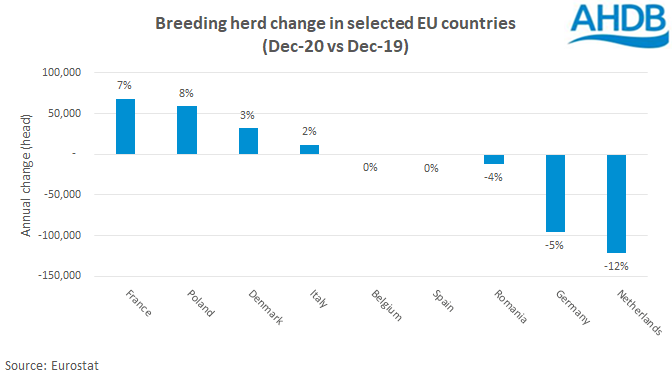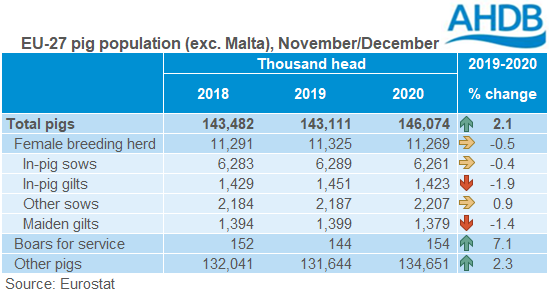EU pig numbers increase with strong growth from Spain
Thursday, 18 March 2021
By Charlie Reeve
The total number of pigs in the EU-27 (excluding Malta)* increased on the previous year in December 2020, totalling 146.1 million head. This was an increase of 3.0 million pigs (2%) compared to the equivalent figure for December 2019.
The largest growth in numbers was seen in Spain, Denmark and Poland. Spain increased its herd size in 2020 by 1.43 million head. Spain was already the EU’s largest producer of pigs and this 5% increase widens the gap further between the other major European pig producing nations. Spain has been able to capitalise on strong trade with Asia and this has also more recently been reflected in Spanish prices.

Denmark’s pig numbers were up by 5% (663,000 head) on the previous year in the census. This increase is likely partly due to fewer pigs being exported to Germany, with a higher number of fattening pigs and piglets being kept in the country.
The German pig herd was largely stable overall, with just 65,000 fewer pigs than the previous census. The lack of growth is unsurprising considering the outbreak of ASF in the country. At the time some finishing pigs were backed up on farms, compensating for falling breeding herd numbers. Even before the ASF outbreak, the German pig herd had been in contraction for several years.
The Netherlands had the largest year-on-year decline in their pig herd with a reduction of 383,000 head (-3%). Environmental regulation and government incentives to exit pig farming have been expected to reduce Dutch pig numbers.

The total EU-27 female breeding herd (ex. Malta) remained stable on the year at 11.3 million head. Falling gilt numbers were largely counteracted by higher numbers of older sows.

The Netherlands had the largest decline in their female breeding pig herd with a decline of 121,000 head (-12%). This was followed by Germany, with a decline of 96,000 head (-5%).
Fattening pigs in the EU-27 (ex. Malta) increased in number by 2% overall. Increases were seen in most categories. Numbers in the heavier weight bands were likely influenced by disruption in abattoirs due to staffing issues during 2020, causing a backlog of pigs at times.
Looking forward
Despite the total number of pigs in the EU-27 (ex. Malta) increasing by 2% year-on-year in 2020, this increase was due to fattening pig numbers, and many of these will have been slaughtered by now. By contrast, the female breeding herd declined marginally year-on-year. Sow productivity does typically increase each year, and so this small decline in sow numbers may not tighten finished pig supplies much in the medium term, if at all. However, the decline in gilt numbers could suggest further breeding herd decline might be on the horizon, affecting longer-term pig supplies.
Any tightening of pig supply in the EU is likely to help support future prices. However, there are many other factors also influencing prices, including the extent of rebuilding in the Chinese pig herd.
* Data is still unavailable for Malta at the time of writing. Malta is a very small pig producer and developments here will not affect overall EU trends. The number of pigs in Malta in 2019 was around 35,000 head.
Sign up for regular updates
Subscribe to receive pork market news straight to your inbox. Simply complete our online form.
While AHDB seeks to ensure that the information contained on this webpage is accurate at the time of publication, no warranty is given in respect of the information and data provided. You are responsible for how you use the information. To the maximum extent permitted by law, AHDB accepts no liability for loss, damage or injury howsoever caused or suffered (including that caused by negligence) directly or indirectly in relation to the information or data provided in this publication.
All intellectual property rights in the information and data on this webpage belong to or are licensed by AHDB. You are authorised to use such information for your internal business purposes only and you must not provide this information to any other third parties, including further publication of the information, or for commercial gain in any way whatsoever without the prior written permission of AHDB for each third party disclosure, publication or commercial arrangement. For more information, please see our Terms of Use and Privacy Notice or contact the Director of Corporate Affairs at info@ahdb.org.uk © Agriculture and Horticulture Development Board. All rights reserved.

